Link to Pubmed [PMID] – 41205160
Link to DOI – 10.1021/jacs.5c13224
J. Am. Chem. Soc. 2025, 147, 43612−43628
Photodynamic therapy (PDT) harnesses the combination of light, oxygen, and photosensitizers to induce cell death via reactive oxygen species (ROS) formation. Given its intrinsic properties, PDT represents an alluring way of stymieing the increasing surge of antimicrobial resistance (AMR). Despite favorable assets, various hurdles need to be circumvented before PDT can efficiently be used to combat AMR. Here, we have evaluated the possibility of generating aptamers equipped with ruthenium polypyridyl complexes against entire Gram-positive Streptococcus pneumoniae bacteria. This combination is hypothesized to improve the poor specificity of photosensitizers, increase PDT efficiency, and potentially penetrate biofilms. Toward these aims, we first prepared nucleotides equipped with various ruthenium complexes and investigated their capacity at serving as substrates for polymerases for enzymatic DNA synthesis. Depending on the nature of the polypyridyl ligands, strong intercalation into dsDNA was observed even when connected to negatively charged nucleotide backbones. We then carried out SELEX and identified two unmodified aptamers that bound to the fixed bacterial target with Kd values of 118 nM and 541 nM. The SELEX experiment with the ruthenium-modified nucleotide led to the identification of one aptamer. The enzymatic synthesis of the modified aptamer was complicated by the formation of a very stable secondary structure confirmed by UV melting experiments (Tm of 84 °C). The modified aptamer displayed a high affinity (Kd value of 125 nM) for fixed Streptococcus pneumoniae bacteria. Collectively, these results highlight the possibility of using nucleotides equipped with large modifications such as ruthenium polypyridyl complexes in SELEX to raise potent aptamers against entire bacterial targets. These findings open directions to convert aptamers into potent devices to combat AMR via PDT-based approaches.






